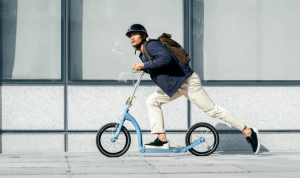Driving a scooter is not exactly like riding a bike; scooters have engines and automatic transmissions, while bikes are manually powered and have a straddle seat.
Understanding the Basics
Scooter and bike features
Scooters and bikes differ in a number of instances, including design, power, and usage. Scooters often feature a step-through frame, automatic transmission, and smaller wheels. Bikes, have a straddling seat, manual transmission, and bigger wheels. Typically, scooters are powered by engines from 50cc to 250cc, whereas the engines of bikes are likely to exceed 1000cc. Scooters are often suitable for short, urban rides that are easy to maneuver and park . Bikes are more versatile in terms of both long distances and harsher and varied terrains.
Similarities of riding experience
Although there are multiple differences, scooters and bikes have similar riding experiences. Both call for balancing and coordination skills while riders also need to be aware of traffic and follow road rules. Both enable feelings of freedom and comfort, while also allowing to avoid traffic jams. A mutual feature is environmental friendliness. Thus, both scooters and bikes consume less fuel in comparison with cars while the portion of emissions is significantly smaller.
Safety Considerations
Helmet Use
Since the safety of the head is crucial for both scooter and bike riders, the first elective measure in that sense would be wearing a helmet . Studies have repeatedly shown that a helmet can reduce the risk of head injury by 69% and death by 42% .
In addition to a helmet, scooters, and bike riders can equip themselves with gloves, jackets as long sleeves, knee pads, etc. This gear will save from most possible abrasions and partially reduce the impact when hitting the ground . Road Safety Rules
Observations of the road traffic rules are also important. These rules define the way the road is intended to be used and in most cases are developed to ensure the maximum safety of the travelers. Scooter and bike riders need to observe all road signs and follow traffic lights, attend vehicle lanes, and not get too close to the cars and motorbikes. They need to observe speed limitations overall, as the higher the speed, the higher the risk of an accident. Scooter riders may also need to be at least 18 years old and have a relevant driver’s license . The rules for passenger usage are laxer for bikes. Both scooter and bike riders need to be perfectly visible in any road situation, including nighttime.
Maneuverability and Control
Handling Differences
Scooters are generally easier to handle than bikes because of their lighter weight and automatic transmission. The vehicles also offer a more upright seating position than that of bikes, and they feature smaller wheels that can work better in tight urban spaces. Bikes require more physical effort to steer and balance, especially at slow speeds. The vehicles are also heavier and larger than scooters, but this provides more stability at increasing speeds. Scooters are, thus, suited for casual rides in the city, while bikes are more versatile for longer rides in different terrains.
Braking Techniques
Proper braking is vital for effective stopping and, thus, safe rides on a scooter or a bike. Scooters will usually feature a handbrake along with a footbrake, and the front brakes tend to be more powerful . Both brakes are, thus, required for effective stopping, and the driver must ensure their simultaneous use. Bikes have tandem handbrake levers that control the front and back brakes separately, and riders should master the application of both of these controls without skidding. The use of the front brake with more force is appropriate in emergency situations to slow down quickly .
